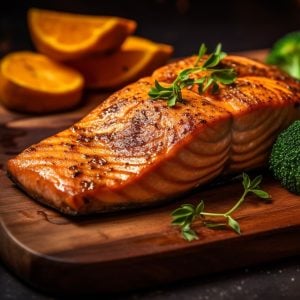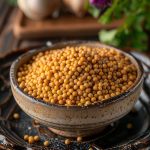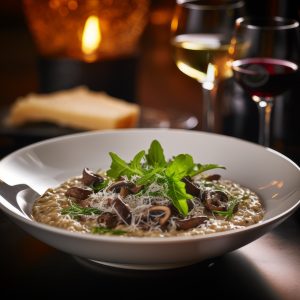Pickled Mustard Seeds Make a Wonderful Garnish
Mustard seeds are the small round seeds of various mustard plants. They come in different colors, including yellow, brown, and black, and have a pungent flavor.
Mustard seeds are commonly used as a spice in cooking, particularly in Indian, Mediterranean, and Middle Eastern cuisines. They can be used whole, crushed, or ground into a powder to add flavor and spice to dishes such as curries, pickles, marinades, and salad dressings.
I’ve used mustard seeds in various spice blends for rubs and bouquet garni but never as a garnish for a protein like fish. I had no idea these tiny seeds (1 – 2 millimeters) would double in size after boiling in water.
More About Mustard Seeds
Mustard seeds have been cultivated for thousands of years and are native to different parts of the world, including Europe, Asia, and North Africa. They belong to the Brassicaceae family, including other cruciferous vegetables like cabbage, broccoli, and kale.
There are several mustard plants, each producing seeds with different flavors and colors. Yellow mustard seeds, also known as white mustard seeds, are the mildest flavor and commonly used in American-style mustard.
Brown mustard seeds are more pungent and are often used in European and Indian cuisines. Black mustard seeds have the strongest flavor and are frequently used in Indian cooking, particularly Southern Indian cuisine.
Mustard seeds contain various beneficial compounds, including antioxidants and essential oils, contributing to their pungent flavor and potential health benefits. They are a good source of nutrients such as selenium, magnesium, and omega-3 fatty acids.
In addition to their culinary uses, mustard seeds have been traditionally used for their medicinal properties. They have been employed in traditional medicine to help with digestion, stimulate appetite, and relieve respiratory congestion. However, it’s important to note that while mustard seeds can have health benefits, they should be consumed in moderation like any other spice.
Mustard seeds are versatile and flavorful ingredients that add depth and complexity to a wide range of dishes, making them a staple in many kitchens worldwide.

Why Pickle Mustard Seeds?
Pickling mustard seeds is a popular way to preserve them while enhancing their flavor and texture. They can add a tangy, acidic bite to dishes and are often used as a condiment or garnish.
- Flavor Enhancement: Pickling adds depth and complexity to the flavor of mustard seeds. The acidic brine used in pickling helps to balance the seeds’ natural bitterness, resulting in a tangy and slightly sweet flavor profile.
- Preservation: Pickling is a traditional method of preserving foods by immersing them in an acidic solution, typically vinegar. This helps to inhibit the growth of bacteria, mold, and yeast, extending the shelf life of the mustard seeds.
- Texture: Pickled mustard seeds have a unique texture that is slightly crunchy and bursts with flavor when bitten. This texture contrasts well with softer foods, adding a delightful dish crunch.
- Versatility: Pickled mustard seeds can be used in a variety of ways. They make a great addition to sandwiches, salads, charcuterie boards, and cheese platters. They can also be used as a topping for meats, seafood, and vegetables or mixed into sauces and dressings to add acidity and tang.
- Creative Culinary Uses: Pickled mustard seeds allow chefs and home cooks to experiment with flavors and textures in their dishes. They can be infused with various herbs, spices, and aromatics to create unique and flavorful condiments that elevate the overall dining experience.
Pickling mustard seeds is a simple yet effective way to preserve and enhance their flavor, making them a versatile and delicious addition to many dishes.
Patience Is A Virtue
I’ll warn you upfront: Making these pickled mustard seeds takes time. Most of that time comes from cooking the 5 cups of water used to pickle them. There was a point when I was preparing these seeds that I thought this damn water was never going to reduce in time to serve with the rest of the meal. I was even prepared to leave it out of the meal, but I’m glad I didn’t. It took a while, but when the liquids started thickening up, it happened quickly and was worth the wait.
Pickled Mustard Seeds Recipe
Ingredients
- 2 tablespoons mustard seeds
- 5 cups water
- 4 tablespoons apple cider vinegar
- 4 tablespoons sugar
- salt & pepper to taste
Instructions
- Heat up a medium sized sauce pan over medium heat and add the mustard seeds. Toast the seeds until they become fragrant. This takes about 2 minutes.
- Either stir or shake the pan to keep the seeds from burning. If burnt, throw them out and start over again.
- Once toasted, add the water, sugar and vinegar. Season with a little salt and pepper and stir all the ingredients to combine.
- Bring the water to a rolling boil and continue cooking until the mustard seeds double in size and the water cooks down to a thickened liquid. This can take 25 - 35 minutes.Be sure to give the liquid a stir occasionally.
- When you get close to the end and the liquid is reduced but just not thickened to the desired consistency, start paying close attention. There is sugar in the liquid so it will get very syrupy before you know it.
- After 30 plus minutes of waiting for this to cook down, you will be surprised at how quickly the liquid reduces in these final minutes. Don't get caught napping.You'll know when you are at the right consistency when the liquid is cooked down to a syrupy viscosity.
- Remove the pan from the heat and transfer the pickled mustard seeds to another bowl for serving.
















